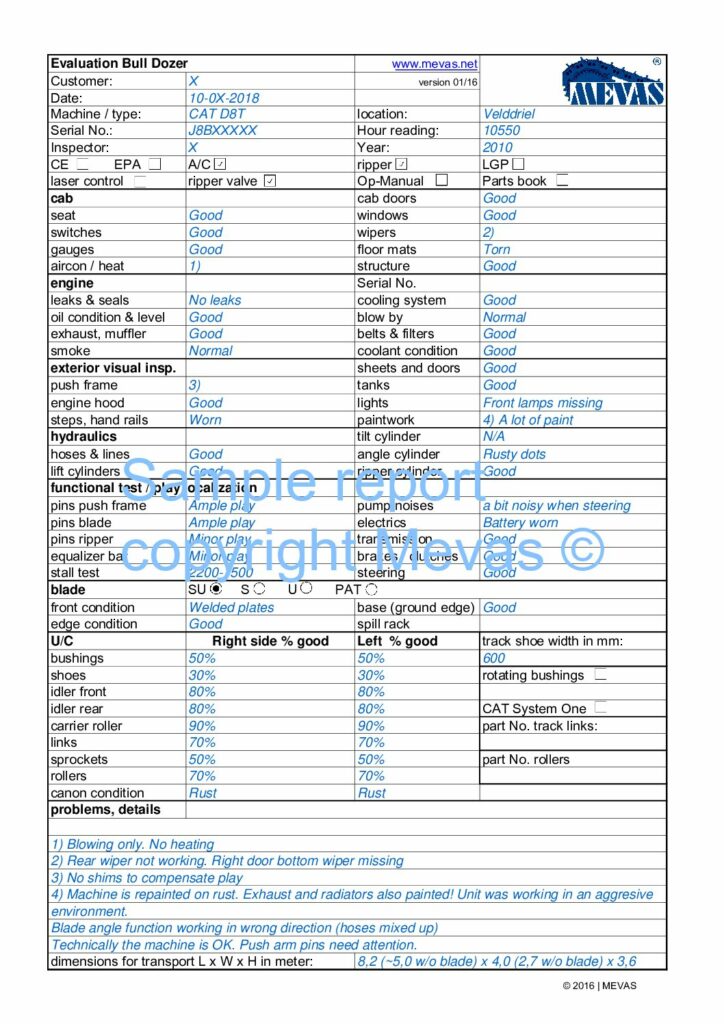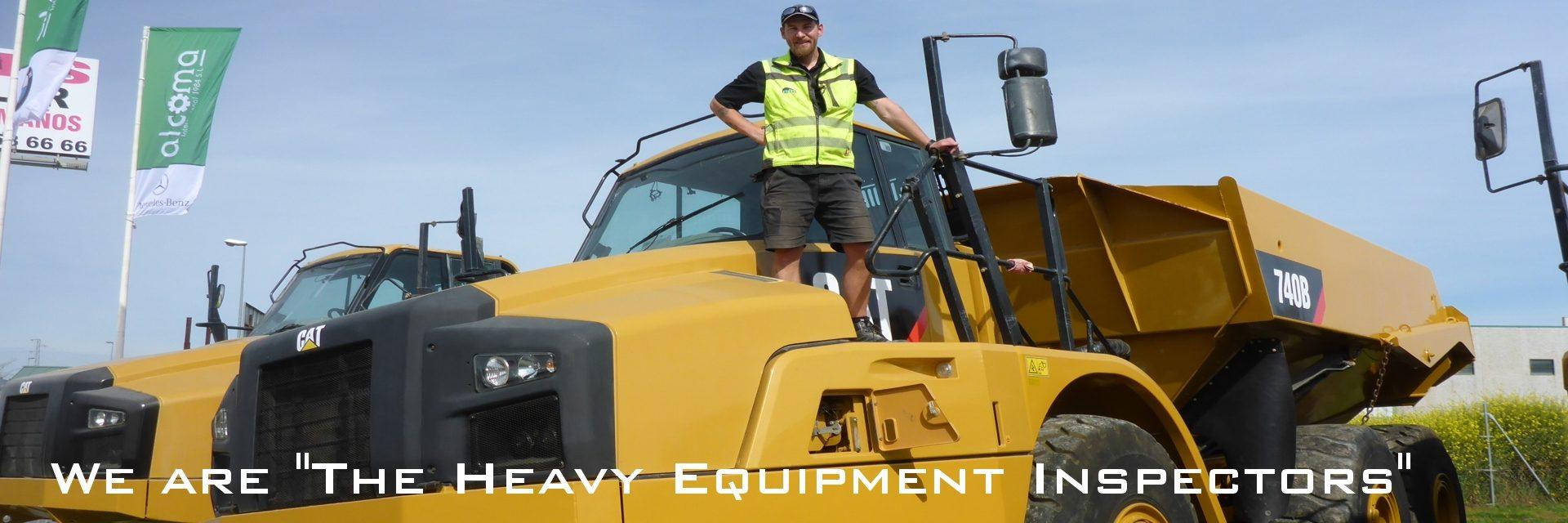If you order a dozer inspection you would receive a detailed report
- Basic Machine information and configurations
- Operator Station details and condition
- Engine information and condition
- Condition of Exterior (push frame, sheet metal, tanks, lights, paint)
- Condition of hydraulic system (pump, performance, hydraulic lines and cylinders)
- Condition of the Blade
- Condition of Undercarriage (tracks, chains, sprockets)
- Functional test
- Comments and recommendation for repairs
- Transport dimensions
See a sample of a report below. On request we can send a PDF-version of such a report.

What extras can you order?
Once you receive an offer, it will be always for a basic walk-around with functional check. This level is called TA1. On our Checklist-Options page you can find additional services which you can order.
If you have questions about the service please contact the team by WhatsApp or by phone +493520639150. We are happy to answer in detail.
Pictures and video coming with a Mevas-Report
Each machine inspection comes along with 50-80 pictures and in some cases with a short video. In case of interest it is possible to see an dozer report in detail on our Google-Drive folder.

Video about the undercarriage measurement at a CAT dozer by Mevas
For larger Caterpillar dozer, we have reference values for the individual components of the Undercarriage. We measure each part and determine the remaining life. You can take a closer look at the measurement process in our video Undercarriage measurement at a Caterpillar dozer on our YouTube-Channel.
Other sample reports heavy machinery
Visit our overview for other sample inspection checklists for heavy machinery.
Keep in mind: Report forms are our legal property and copying is a violation of our copyright.
Which details should a reasonable checklist for inspection of a used bulldozer contain?
Inspecting a used bulldozer is crucial to ensure that it meets your requirements and is in good working condition. Here’s a checklist to guide you through the inspection process:
- Overall Inspection:
- Check for visible signs of damage or welding on the frame.
- Look for any signs of oil or fluid leaks underneath the machine.
- Inspect the condition of the paint for rust, peeling or excessive wear.
2. Undercarriage:
- Check the tracks or tires on wheel dozers for wear, damage, or uneven tread wear.
- Inspect the rollers, idlers and sprockets for excessive wear.
- Measure the track tension to ensure it meets the manufacturer’s specifications.
3. Engine:
- Start the engine and check for unusual noises, smoke, blow-by or vibrations.
- Inspect for oil and coolant leaks around the engine and related components.
- Check the air filter for cleanliness.
4. Hydraulics:
- Test all hydraulic functions, including the blade movement.
- Look for leaks in hydraulic hoses and connections.
- Check the hydraulic fluid level and condition.
5. Transmission and Drive train:
- Test the transmission through all gears, forward and reverse.
- Check for any unusual noises during operation.
- Inspect the condition of the drive shafts and final drives.
6. Blade:
- Check the blade for signs of damage, wear, or bending.
- Test the functionality of the blade or bucket tilt and lift.
- Ensure that the cutting edges are in good condition.
7. Cab and Controls:
- Inspect the condition of the cab, looking for damage, rust or water leaks.
- Test all controls, heating, cooling and warn lights for smooth operation.
- Check the condition of the operator’s seat and seatbelt.
8. Electrical System:
- Inspect the battery for age and condition. Check if alternator is charging.
- Test all lights, indicators and gauges.
- Check the condition of wiring and connectors.
9. Fluids and Lubricants:
- Check the levels of engine oil, transmission fluid, hydraulic fluid and coolant.
- Inspect the color and condition of these fluids.
- Documentation:
- Request and review maintenance records, service history, and any available inspection reports.
- Check the serial number and verify it against the provided documentation.
- Operational Test:
- Take the bulldozer for a test drive to evaluate its performance.
- Pay attention to how it steers, accelerates and brakes.
- Tires/Tracks:
- Inspect the condition of tires or tracks for any signs of damage or excessive wear.
Always consider having a qualified mechanic or a Mevas technician perform a thorough inspection if you are not experienced in evaluating heavy equipment. Additionally, consulting the manufacturer’s guidelines and specifications for the specific model of the bulldozer is essential for a comprehensive assessment.
Liste de contrôle pour une bulldozer
Tu trouveras ici un exemple de liste de contrôle pour une bull ou bulldozer. Cette fiche d’inspection est utilisée pour inspecter les machines d’occasion. 60 points sont contrôlés et l’inspecteur note toutes ses observations et décrit les défauts constatés. Tu trouveras une liste de tous les formulaires disponibles ICI. La version de la liste de contrôle présentée ici n’est pas la version la plus récente. Nos rapports d’inspection sont régulièrement mis à jour.

